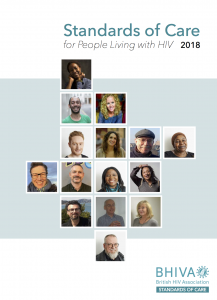A new framework for best HIV care: BHIVA Standards of Care revised and updated (2018)
1 May 2018. Related: Conference reports, Guidelines, BHIVA/BASHH 4th Edinburgh 2018.
 Roy Trevelion, HIV i-Base
Roy Trevelion, HIV i-Base
The revised BHIVA Standards of Care for people living with HIV are primarily produced as a reference for commissioning HIV services. It also describes a minimum standard of care that HIV positive people can use as a reference.
These 90-page guidelines were last updated in 2013 and this third edition was launched at the 4th Joint BHIVA/BASHH Conference in Edinburgh.
The Standards was produced by a writing group of more than 90 individual doctors, health workers and people living with HIV. It was a collaboration with numerous professional associations, commissioners and community groups.

The main changes to this edition include:
- Reducing the number of standards from 12 to 8, but with each one covering broader themes.
- A new section is included on person-centred care. This includes wider aspects of social circumstances, including stigma and discrimination, self-management, peer support and general well-being. The importance of these issues are emphasised by this being an early chapter.
- Recognising the new U=U consensus: an undetectable viral load means HIV cannot be sexually transmitted – with or without a condom (although some sections of the document have inconsistent information on U=U that will hopefully be quickly updated).
- The section on complex care has been broadened with more detail about access to specialist non-HIV treatment.
- Another new section covers HIV across the life course covers HIV treatment and care from adolescence to end of life. This includes palliative care in the context that ART might continue to work well to the very end of life.
There are now eight chapters covering major themes. Each chapter and subsection includes quality statements and auditable targets.
Standard 1 covers testing, diagnosis and prevention and the 90:90:90 goals to eradicate HIV. All three areas are ways to maintain and develop combination prevention. This includes increased testing, early treatment, viral suppression and PrEP. Combination prevention helped bring about the dramatic reduction in HIV transmission seen recently in the UK. HIV positive people are important partners in combination prevention.
Standard 2 is about person-centred care. This has been described as “the fourth 90” and focusses on the whole person, not just HIV. BHIVA say it considers, “desires, values, family situations, social circumstances, and lifestyles. And in so doing, the needs and preferences of HIV positive people can be responded to in humane and holistic ways.” It challenges HIV stigma and discrimination and works towards equality in health and social care. Social inclusion and well-being – crucially aided by peer support – are key to person-centred care.
Standard 3 covers HIV outpatient care and treatment. Anyone newly diagnosed must be seen by a specialist HIV doctor within two weeks and given access to psychological and peer support. In some cases this referral needs to be within 24 hours. There is no gold standard for measuring engagement in care, but transfer of care should be seamless whether a person moves home, is incarcerated or simply moves to another clinic. Increasing numbers of children living with HIV from birth are now becoming adolescents. Management by interdisciplinary teams must ensure successful transition to adult HIV services. A qualified doctor must prescribe ARVs and monitoring according to current national guidelines.
Standard 4 is about complex HIV care. Inpatient care must ensure that an HIV specialist is included in the hospital multidisciplinary team. HIV positive people are living longer and often go into hospital for non-HIV related problems. They may be cared for safely and appropriately in a local ward or clinic. But they must also be supported by immediate and continued HIV expertise and advice. HIV positive people must have access to specialist services for other conditions such as cancer. But clear protocols and agreed pathways are essential for safe delivery of services. This section also includes supporting people with higher levels of need. It includes successful management of multiple long-term conditions, poor mental health, poor sexual health, and problems with alcohol or substance use.
Standard 5 is on sexual and reproductive health. It is important that HIV positive people are supported in maintaining healthy sexual lives for themselves and their partners. In addition, anyone at risk of other STIs and infectious hepatitis, perhaps through drug use, should be supported and given advice. Care should be given for contraception, fertility services, pregnancy planning, and access to abortion services. Care must ensure that babies are born healthy and HIV negative. Care for the mother’s health is key to giving birth to a healthy baby.
Standard 6 is on psychological care. HIV positive people should receive care and support that assesses, manages and promotes their emotional, mental and cognitive wellbeing and health. This should be sensitive to the unique aspects of living with HIV. HIV positive people have higher rates of depression, anxiety, addictions, self harm, and other mental health issues than the general population. Mental health needs must be screened on an annual basis. This includes screening for poor cognitive function that can cause memory problems and reduce ability to perform simple tasks.
Standard 7 covers HIV across the life course. This section looks at standards of care for everyone who is HIV positive. Management of ART should be individualised at every age. It starts with adolescents (aged 10 to 19 years) and young adults (aged 20 to 24 years). Education and personal development – as well as achieving healthy sex lives and relationships – should be supported by experienced sexual health advisers and specialist nurses.
The years from 25 to 65 are described as early to middle adulthood. Most people in this age group are diagnosed as adults. Care for early diagnosis and treatment should include peer support as well as psychological support. HIV positive people should be supported in having healthy and fulfilling sex lives and engaged in treatment as prevention (U=U).
The over 65s – whether newly diagnosed or long-time positive – should be given access to treatment for complex comorbidities. This is an area of significant emerging knowledge and will likely develop over the course of these standards. Successful care may be achieved through co-speciality clinics, mentoring schemes, or by identified experts in advice and guidance. Palliative care is now included here. Palliative care ensures that the individual and their family are supported, receive appropriate care that meets their needs and preferences, and do not experience unnecessary suffering
Standard 8 covers developing and maintaining excellent care. This standard covers knowledge and training to ensure specialist services are provided. It sets standards for monitoring, auditing, research and commissioning. It also sets standards for public health surveillance, confidentiality and information governance.
Roy Trevelion is a community representative on the Standards writing group.
comment
These comprehensive Standards are very welcome.
The community was involved at every stage from planning to the final draft, with at least one community representative on each chapter and more than 15 UK-CAB members collaborating overall.
The result is a comprehensive benchmark for health and wellbeing for HIV positive people.
All sections provide bullet points for measurable and auditable outcomes and must be promoted in primary and secondary care, health & social care, public health, and local authority healthcare provision.
As bureaucratic and structural changes affect the structure of HIV services, these Standards should be a reference for ensuring that high-quality care for HIV positive people is maintained.
The inconsistent messaging over undetectable viral load and HIV transmission will hopefully be corrected. As the publication is only available in PDF format, this should be relatively easy. Several formatting problems, including difficult legibility (light font, justified text) would benefit from being revised.
It is good to see the inclusion of HIV positive people in the photographs throughout the report, supported by the UK-CAB and Positively UK.
Reference
BHIVA. British HIV Association Standards of care for people living with HIV 2018. April 2018.
http://www.bhiva.org/standards-of-care-2018.aspx

